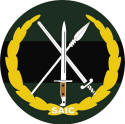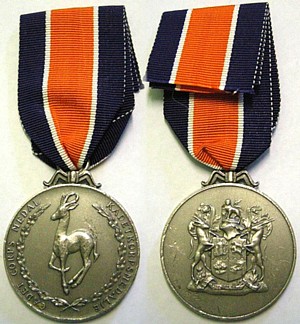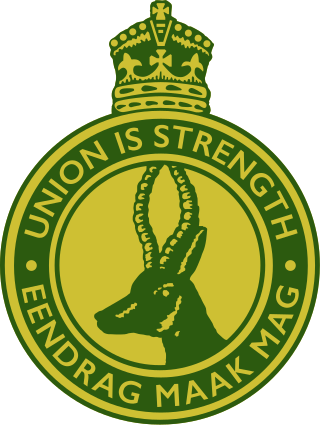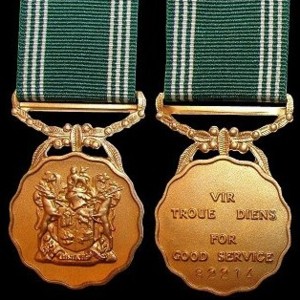Related Research Articles

The South African Army is the principal land warfare force of South Africa, a part of the South African National Defence Force (SANDF), along with the South African Air Force, South African Navy and South African Military Health Service. The Army is commanded by the Chief of the Army, who is subordinate to the Chief of the SANDF.

The South African Defence Force (SADF) comprised the armed forces of South Africa from 1957 until 1994. Shortly before the state reconstituted itself as a republic in 1961, the former Union Defence Force was officially succeeded by the SADF, which was established by the Defence Act of 1957. The SADF, in turn, was superseded by the South African National Defence Force in 1994.
The Permanent Force was an integral part of both the South African Defence Force and the South West Africa Territorial Force which consisted of all the full-time volunteers, volunteers of Auxiliaries and national servicemen.
The Defence Intelligence Division of the South African National Defence Force is the primary military intelligence agency of South Africa which came into being on 27 April 1994. The other intelligence agencies of the country are:

The South African Army Infantry Formation supervises all infantry within the South African Army.

The Pro Merito Decoration, post-nominal letters PMD, is a military decoration for merit which was instituted by the Republic of South Africa on 1 July 1975. It was awarded to other ranks of the South African Defence Force for outstanding service of the highest order and utmost devotion to duty.

The Cadet Corps Medal is a military medal which was instituted by the Republic of South Africa in 1966. It could be awarded to officers in the School Cadet Corps for twenty years efficient service. A clasp could be awarded after 30 years qualifying service.

The Union Defence Force (UDF) comprised the armed forces of South Africa from 1 July 1912, when the Defence Act took effect, two years after the creation of the Union of South Africa, until 1957 when it was reorganised and renamed the South African Defence Force (SADF).

The Medal for Distinguished Conduct and Loyal Service is a South African military medal which was instituted by the Republic in 1987. It was awarded to members of the South African Defence Force for forty years of loyal service and distinguished conduct.

The first South African military medal was a campaign medal, the South Africa Medal, instituted in 1854 by Queen Victoria, the sovereign of the United Kingdom of Great Britain and Ireland, for award to officers and men of the Royal Navy and British Army who served on the Eastern Frontier of the Cape Colony between 1834 and 1853 during the Xhosa Wars.

The Good Service Medal, Bronze, originally named the South African Defence Force Good Service Medal, Bronze, is the junior of a set of three South African military medals which was instituted by the Republic on 1 July 1975. It was awarded to members of all elements of the South African Defence Force for ten years of exemplary service, but was restricted to Permanent Force personnel from 1993.

The Good Service Medal, Silver, originally named the South African Defence Force Good Service Medal, Silver, is the middle member of a set of three military medals which was instituted by the Republic of South Africa on 1 July 1975. It was initially awarded to members of all elements of the South African Defence Force for twenty years of exemplary service, but was restricted to Permanent Force personnel from 1993.

The Good Service Medal, Gold, originally named the South African Defence Force Good Service Medal, Gold, is the senior of a set of three military medals which was instituted by the Republic of South Africa on 1 July 1975. It was initially awarded to members of all elements of the South African Defence Force for thirty years of exemplary service, but was restricted to Permanent Force personnel from 1993.

6 Medical Battalion Group is a Medical Battalion in the South African Military Health Service (SAMHS). SAMHS is the fourth Arm of Service of the South African National Defence Force (SANDF).

111 Battalion was a motorised infantry unit of the South African Army.

113 Battalion was a motorised infantry unit of the South African Army.

151 South African Infantry Battalion was a motorised infantry unit of the South African Army.

111 Battalion was a motorised infantry unit of the South African Army.

15 Reception Depot was an administrative unit of the Personnel Service Corps of the South African Army.
References
- 1 2 Jacklyn Cock, Laurie Nathan (1989). War and Society: The Militarisation of South Africa. New Africa Books. pp. 17–19. ISBN 978-0-86486-115-3.
- ↑ "A Brief History of the South African Defence Force (SADF) 1912 1994. Part1". Allexplore.com. Retrieved 27 November 2013.
- ↑ "South Africa-Early Development of the South African Military". Mongabay.com. Retrieved 27 November 2013.
- ↑ Library of Congress Country Studies: South Africa, Early Development of the South African Military, 1996
- 1 2 3 4 5 6 7 Grundy, Kenneth (1986). The Militarization of South African Politics. Bloomington: Indiana University Press. pp. 7, 22–24. ISBN 978-0253316783.
- 1 2 3 4 Peled, Alon (1998), A Question of Loyalty: Military Manpower Policy in Multiethnic States, Cornell Studies in Security Affairs, Ithaca: Cornell University Press, pp. 73-76, ISBN 0-8014-3239-1
- 1 2 3 4 Le Roux, Len (10 March 2005). "Submission on the Status of the South African Defence Force's Reserves" (PDF). Pretoria: Institute for Security Studies. Archived from the original (PDF) on 6 April 2018. Retrieved 6 April 2018.